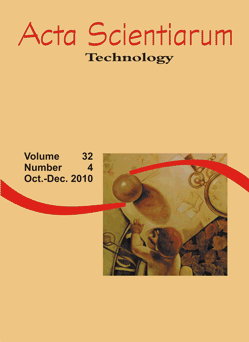<b>Improvement of the electrochemical determination of antioxidant using cationic micellar environment</b> - 10.4025/actascitechnol.v32i4.6945
DOI:
https://doi.org/10.4025/actascitechnol.v32i4.6945Palavras-chave:
ascorbic acid, micellar system, cationic surfactantResumo
Ascorbic acid (AA) is an important compound of the human diet, in the metabolism acting mainly as exogenous antioxidant. A method for electrochemical detection of Ascorbic acid (AA) with a GCE was developed using a cationic surfactant cetylpyridinium chloride (CPC). The presence of CPC influences the electrochemical behaviour of AA, reduces the applied potential to measure AA oxidation followed by an increase in the peak current. In the optimized conditions the AA determination was possible in the linear range of 5.0 x 10-7 mol L-1 - 4.3 x 10-4 mol L-1 with a detection limit (S/N = 3) of 2.0 x 10-7 mol L-1. The applicability of the method is in the sensitivity and selectivity of the GCE for the AA detection as well as the simplicity of the demonstrated method using an electrode without modifying and without pre-treatment of samples. Recovery tests presented values of 98 - 103% suggesting the method has no significant interference and making possible to be successfully used for AA determination in complex samples.Downloads
Downloads
Publicado
Como Citar
Edição
Seção
Licença
DECLARAÇíO DE ORIGINALIDADE E DIREITOS AUTORAIS
Declaro que o presente artigo é original, não tendo sido submetido í publicação em qualquer outro periódico nacional ou internacional, quer seja em parte ou em sua totalidade.
Os direitos autorais pertencem exclusivamente aos autores. Os direitos de licenciamento utilizados pelo periódico é a licença Creative Commons Attribution 4.0 (CC BY 4.0): são permitidos o compartilhamento (cópia e distribuição do material em qualqer meio ou formato) e adaptação (remix, transformação e criação de material a partir do conteúdo assim licenciado para quaisquer fins, inclusive comerciais.
Recomenda-se a leitura desse link para maiores informações sobre o tema: fornecimento de créditos e referências de forma correta, entre outros detalhes cruciais para uso adequado do material licenciado.



















